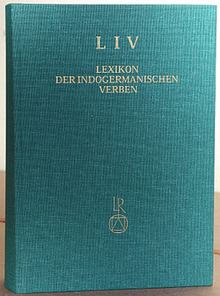Publication date 1998, 2001 ISBN 3-89500-219-4 Originally published 1998 Page count 754 Country Germany | Dewey Decimal 415/.03 21 OCLC 47295102 | |
 | ||
Publisher Dr. Ludwig Reichert Verlag Pages 754 (1st edition),823 (2nd edition) Similar Indogermanisches etymologisches Wörterbuch, Encyclopedia of Indo‑Euro, Etymological Dictionary of Proto, Comparative Indo‑European Linguistic, Indo‑European Language and Cultu | ||
The Lexikon der indogermanischen Verben (LIV, "Lexicon of the Indo-European Verbs") is an etymological dictionary of the Proto-Indo-European (PIE) verb. The first edition appeared in 1998, edited by Helmut Rix. A second edition followed in 2001. The book may be seen as an update to the verb entries of the Indogermanisches etymologisches Wörterbuch (IEW) by Julius Pokorny. It was the first dictionary fully utilizing the modern three-laryngeal theory with reconstructions of Indo-European verbal roots.
Contents
The LIV's hypothesis about aspect
The authors of the LIV assume a dichotomy between telic verbs (terminated: for example, *leh₂p- 'to light up') and atelic verbs (ongoing: for example, *bʰeh₂- 'to shine') in early stages of Proto-Indo-European. Before the daughter languages split off, aspect emerged as a new grammatical category.
Telic verbs were interpreted as aorist forms, and the missing present was formed with various suffixes (for example, *leh₂p-: *l̥h₂p-sḱé-) and the nasal infix (*l̥h₂-né-p-), all of which are supposed to come from old grammatical forms of uncertain meaning.
Atelic verbs were interpreted as present forms, and the missing aorist was formed with the suffix -s-, yielding the sigmatic aorist.
This hypothesis is used to explain various phenomena:
In addition to the present and the aorist, the following aspects are assumed:
Entries
The lexical part contains for each verbal root
Indices
The book includes
